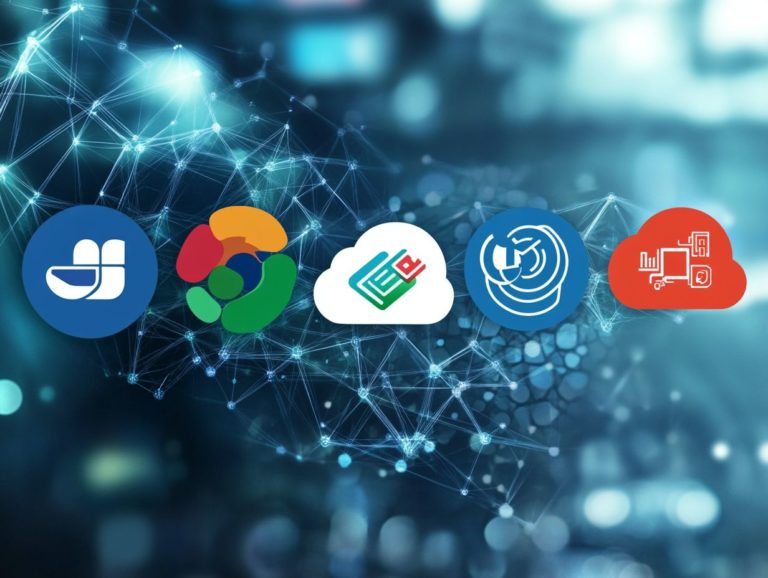5 Top PaaS Trends in 2024
Welcome to 2024! Discover how transformative changes in the Platform as a Service (PaaS) landscape are reshaping your app development and deployment. PaaS, or Platform as a Service, allows you to build and manage applications without dealing with the underlying infrastructure.
With the emergence of hybrid solutions, enhanced security measures, and the increasing appeal of low-code and no-code platforms, these trends signify a broader shift towards efficiency and innovation in your business practices.
This article will delve into the key developments fueling the PaaS evolution, shedding light on their implications for your operations and what the future may have in store for you. Let s dive into the trends that will redefine your PaaS experience!
Contents
- Key Takeaways:
- 1. Rise of Hybrid PaaS Solutions
- 2. Increased Focus on Security and Compliance
- 3. Emergence of Low-Code and No-Code Platforms
- 4. Growing Importance of DevOps in PaaS
- 5. Integration with Artificial Intelligence and Machine Learning
- What Is PaaS and Why Is It Important?
- How Has PaaS Evolved in the Past Few Years?
- What Are the Key Factors Driving the Growth of PaaS?
- What Are the Challenges Faced by PaaS Providers?
- What Can We Expect from PaaS in the Future?
- Frequently Asked Questions
Key Takeaways:

- Hybrid PaaS solutions will lead the market in 2024, offering unmatched flexibility and scalability.
- Security and compliance will be a top priority, as companies focus on data protection.
- Low-code and no-code platforms will become the norm, empowering non-technical users to develop and deploy applications.
- DevOps, the collaboration between development and operations teams, will enhance application delivery.
- PaaS will integrate with artificial intelligence and machine learning for improved capabilities and data-driven insights.
1. Rise of Hybrid PaaS Solutions
The rise of hybrid platform-as-a-service (PaaS) solutions is transforming your cloud computing landscape. These solutions allow you to harness the advantages of both cloud-native environments and on-premises infrastructures. This approach enhances your operational efficiency and cost-effectiveness.
As you seek greater flexibility in application deployment and disaster recovery strategies, hybrid PaaS solutions become increasingly vital for managing diverse workloads across multiple cloud providers, including Microsoft Azure, Amazon Web Services, and Google Cloud.
These solutions seamlessly connect with your existing IT infrastructure, optimizing resource utilization while minimizing downtime. By enhancing application functionality, they support a more agile development process, allowing you to swiftly deploy updates and new features.
Hybrid PaaS solutions also bolster your data management with robust security measures and compliance protocols, protecting sensitive information and creating a more secure and efficient computing environment.
As you navigate an increasingly complex digital landscape, adopting such hybrid solutions emerges as a strategic choice for maximizing your technological investments.
2. Increased Focus on Security and Compliance
As cloud computing evolves, you will see a stronger emphasis on security and compliance. Organizations are prioritizing data security and privacy protection to shield sensitive information from breaches.
This heightened focus has prompted cloud providers to adopt a multi-layered approach, integrating advanced encryption techniques and stringent security protocols. By implementing robust encryption during transmission and while data is at rest, they ensure that your information remains inaccessible to unauthorized parties.
Adhering to established security frameworks, like ISO 27001 and SOC 2, further supports regulatory compliance. These rigorous measures not only strengthen the overall security posture but also significantly enhance your trust as a user.
When you feel confident in the safety of your data, you are more likely to embrace cloud services as dependable solutions for your operational needs.
3. Emergence of Low-Code and No-Code Platforms
The rise of low-code and no-code platforms is transforming app development, giving you the power to create robust applications even with minimal programming knowledge. This shift significantly enhances user experience.
These innovations streamline the app development process and positively impact cloud solutions and operational efficiency across various industries. By enabling teams to rapidly prototype and deploy applications, you can respond to market changes in real time, effectively reducing downtime and optimizing resource utilization.
Consider a compelling case study from a retail company that integrated these platforms with cloud infrastructure, achieving a 30% reduction in development time and fostering improved collaboration among departments.
Such outcomes highlight the versatility of these tools, catering to a diverse range of user needs from simplifying complex workflows to empowering non-technical staff in crafting customized solutions.
4. Growing Importance of DevOps in PaaS

The growing significance of DevOps in platform-as-a-service (PaaS) is transforming how you approach application deployment. It highlights the need for collaboration between development and operations teams to enhance resource scaling and operational efficiency.
By embracing DevOps methodologies, you can automate workloads more effectively, ensuring that your applications run seamlessly in cloud environments. This approach accelerates your deployment times and minimizes the risk of errors, leading to more reliable service delivery.
Consider tools like Jenkins for continuous integration and Docker for containerization. Containerization is a method of packaging software so it can run consistently across different computing environments, and these tools exemplify how automation can optimize your processes.
By adopting best practices such as Infrastructure as Code (IaC), a practice that allows you to manage your infrastructure using code, similar to writing software, with Terraform, you empower yourself to manage infrastructure through code. This enables you to schedule workloads efficiently and adapt to shifting demands without compromising quality.
5. Integration with Artificial Intelligence and Machine Learning
The integration of artificial intelligence and machine learning into cloud solutions is opening doors to new possibilities for real-time services. This allows you to gain deeper insights into user behavior and utilize AI functionalities for superior decision-making.
This approach helps you respond quickly to market changes while improving efficiency. Businesses across various sectors are leveraging these technologies to refine their data access methods, making it easier for you to analyze data quickly and make informed decisions.
For example, in the retail sector, AI-driven analytics empower you to create personalized shopping experiences through targeted recommendations, significantly enhancing customer engagement. In healthcare, cloud-enabled machine learning models assist in predicting patient outcomes by analyzing vast datasets, ultimately leading to improved care strategies.
Real-world applications like these clearly demonstrate how AI and cloud solutions combine to drive innovation and boost operational efficiency in your organization. Don’t miss out on the chance to leverage AI and machine learning to elevate your business today!
What Is PaaS and Why Is It Important?
Platform-as-a-service (PaaS) stands as a vital pillar of cloud computing, offering you a robust framework to build, deploy, and manage applications without the headaches of handling the underlying infrastructure. This not only enhances your operational efficiency but also paves the way for cost-effective cloud migration strategies.
In today s fast-paced technology landscape, PaaS provides a significant degree of abstraction. This allows your team to concentrate on coding and innovation instead of being bogged down by server management.
Various cloud providers, like Google Cloud Platform and Microsoft Azure, present tailored PaaS solutions designed to meet diverse development needs. This gives your organization the power to streamline application deployment processes, helping you reach your target audience more swiftly.
By automating routine tasks such as scaling and maintenance, PaaS solutions lighten your operational load. This enables your team to redirect resources toward enhancing features and elevating the overall user experience. This focus boosts your competitive edge.
What Are the Different Types of PaaS?
There are various types of platform-as-a-service (PaaS), each tailored to meet distinct needs within cloud-native and hybrid cloud environments. These include serverless databases and specialized application functions.
Among these options, cloud-native PaaS provides seamless scalability and rapid development capabilities, making it especially attractive for startups and organizations that value agility.
On the other hand, hybrid cloud PaaS excels in integrating on-premises resources with cloud solutions, enabling you to leverage existing infrastructure while enjoying the flexibility that the cloud offers.
If you prefer to eliminate the hassle of server management altogether, serverless PaaS options allow you to concentrate solely on coding and deployment.
This diversity in PaaS types empowers you to choose a solution that aligns perfectly with your operational needs and development objectives.
How Has PaaS Evolved in the Past Few Years?

In recent years, you ve likely noticed how platform-as-a-service (PaaS) has transformed dramatically. This shift has been fueled by advancements in cloud migration technologies and a surge in demand from cloud providers.
Furthermore, there is a pressing need for efficient disaster recovery strategies that enhance resource scaling. This evolution represents a pivotal moment for businesses like yours as they adapt their IT infrastructures to tackle the challenges posed by a rapidly moving digital landscape.
The rise of containerization and microservices means you can deploy applications at lightning speed while retaining the flexibility and scalability that today s environment demands.
Take a cue from companies like Spotify, which have successfully harnessed PaaS solutions to streamline their development processes. This allows them to devote more time to innovation rather than the complexities of hardware management.
As the market increasingly shifts toward hybrid and multi-cloud strategies, it s time for you to rethink your deployment models. This approach leads to significant cost savings and enhances resilience, giving your business the power and agility needed to thrive in an ever-evolving landscape.
What Are the Key Factors Driving the Growth of PaaS?
Several key factors are propelling growth in the platform-as-a-service (PaaS) landscape. These include the increasing demand for enhanced operational efficiency, cost-effectiveness, and improved user experience in cloud computing solutions.
These factors are intricately linked to rapid technological advancements that facilitate quicker deployment and scalability. The rising market demand for flexible deployment options compels businesses like yours to seek platforms that allow for seamless integration and customization.
As user needs change, especially with digital transformation, your approach should adapt.
For instance, a report by Gartner indicates that the global PaaS market is projected to reach an impressive $166 billion by 2026. This showcases a compound annual growth rate of 23%, underscoring the importance for businesses to prioritize innovative solutions. Keeping an eye on the future of SaaS is essential as it aligns effortlessly with modern operational needs.
What Are the Challenges Faced by PaaS Providers?
PaaS providers encounter a multitude of challenges, such as ensuring data security and compliance, efficiently managing network traffic, and seamlessly integrating their offerings within increasingly complex hybrid cloud environments. Hybrid cloud environments combine on-premises resources with cloud services.
To effectively navigate these hurdles, you must adopt robust security frameworks that safeguard sensitive data and adhere to various regulations across different regions.
You might discover that combining on-site and cloud resources presents difficulties, potentially leading to performance bottlenecks. The solution lies in leveraging advanced monitoring tools and automated orchestration strategies that streamline operations while bolstering security postures.
By addressing these pain points, PaaS providers can craft a more seamless user experience and foster trust with their clientele.
What Can We Expect from PaaS in the Future?
The future of platform-as-a-service (PaaS) looks incredibly promising, with popular PaaS use cases in 2024 showcasing trends that indicate enhanced security measures, greater integration of AI functionalities, and a commitment to eco-friendly practices in cloud computing.
As these technologies continue to evolve, you can anticipate a more streamlined development process that enables rapid deployment of applications without sacrificing safety.
The integration of machine learning into PaaS will give you the power to create smarter applications capable of predicting user behavior and optimizing performance in real-time. This transformation elevates the user experience and significantly cuts operational costs, ultimately driving greater efficiency.
With sustainability taking center stage, PaaS providers are likely to embrace greener technologies, prompting you to rethink your IT infrastructure and prioritize environmentally friendly solutions. Act now to stay ahead of the competition as these transformations unfold.
Frequently Asked Questions

Here are some frequently asked questions about PaaS:
- What is PaaS?
- How does PaaS differ from IaaS and SaaS?
- What are the benefits of using PaaS?
Stay updated on PaaS trends to ensure your business stays competitive.
What are the top PaaS trends expected in 2024?
In 2024, expect increased adoption of serverless computing, hybrid PaaS solutions, and a strong focus on security. For insights on the leading options, check out the top 10 PaaS providers in 2024, as AI-driven platforms and no-code/low-code options will also emerge as key trends.
How will serverless computing impact PaaS in 2024?
Serverless computing will gain traction in 2024, making it essential to explore the top cloud storage services that support this shift, leading to more efficient application development and deployment through event-driven architectures.
What are hybrid PaaS solutions?
Hybrid PaaS solutions combine on-premise and cloud platforms for a flexible IT infrastructure. As organizations look ahead, they will increasingly seek customized solutions and adapt to the top trends in cloud migration for 2024.
How will security and compliance affect PaaS in 2024?
PaaS will prioritize security and compliance in 2024, as businesses will demand robust features to protect data and meet regulations. Additionally, keeping an eye on the top hybrid cloud trends to watch in 2024 will be crucial for staying ahead.
What role will AI play in PaaS in 2024?
AI-driven PaaS platforms are set to surge in 2024, and alongside this, IaaS trends to watch in 2024 will also play a significant role, using machine learning to automate and enhance application development and management.
What are the benefits of no-code/low-code PaaS offerings?
No-code/low-code platforms will simplify and accelerate app development in 2024. They empower non-technical users to create applications easily, making it more accessible for businesses.






